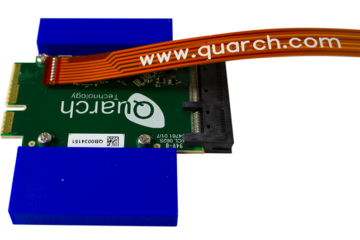
Andy Norrie
PCIe Gen6 is here, and building test equipment for it is NOT simple. The signal integrity challenges require us to use the best possible materials and RF switches. Gen6 compatible switches are expensive, so we’ve designed a range of modules to let you choose the best option for each test you need to run.
What’s changed for Gen6?

Which Gen6 breaker will you need? There are changes to be aware of. For Gen5 and earlier, we had two main breaker versions.
 ‘High Speed’ modules with switches on all the data lanes, and a full feature set
‘High Speed’ modules with switches on all the data lanes, and a full feature set
‘Lite’ modules, with direct routing on the data lanes and no FPGA, so the feature set was reduced (no pin bounce or glitch).
With Gen6 devices we will have an FPGA and a full feature set on every device. This means that ALL breakers will be capable of the advanced features:
-
- High resolution hot-plug timings
- Pin bounce
- Sideband driving
- Glitching
Gen6 breakers will be immediately compatible with PCIe, NVMe, CXL, and OCP, as with our earlier generations.
The differences will be in the control of the PCIe data lanes. Here are examples, using the AIC/Slot range of breakers to show the new terminology:
Gen6 x16-16 Breaker
This is a 16 lane AIC breaker, with individual RF switching on all 16 lanes (4 switches per lane, 2 for Tx and 2 for Rx).
Gen6 x8-8 Breaker
An 8-lane AIC breaker, with all 8 lanes switched. A de-populated x16 breaker, so it will still fit into an x16 slot. (If customers need to go direct into an x8 slot in the future, will we look at making another breaker)
Gen6 x16-1 Breaker
This is a 16 lane AIC breaker, with switches ONLY on Lane0. The remaining 15 lanes are directly connected. Removing the switches allows for a much lower-cost breaker, but having control over Lane0 will be enough to fail the data link (unless you are using lane reversal or bifurcation).
The x16-1 breaker is also a simple way to evaluate the solution. It is cheaper to send out and allows a customer to test if Lane0 runs error-free on their test setup.
Gen6 x16-0 Breaker
This is what we called a ‘Lite’ breaker in the past. It has no switches on any of the PCIe data lanes, they are directly routed through the board.
The Gen6 version is a lot more powerful than previous Lite Breakers, though; it supports every other feature of the full x16-16 breaker.
External triggering
All variants of the x16 breakers will have external triggering enabled as standard:
-
- Sync a glitch or power event to an analyser or other external test equipment
- Trigger out to a PPM, to create a custom power ramp during hot-plug
- Monitor sideband signals by outputting them to the triggering connectors (for example, tap SMBUS and send it to an analyser without needing to get probes into the system).
When do you NOT need the expensive option?
There are many test cases where you can save money by choosing the right product. If you are doing lane reduction tests on an x16 switch or device, you will need full lane control, so choose x16-16.
Here are just a few example tests where it is not needed, though:
- SMBUS testing
You can break REFCLK, or drive it to lock up the bus with any of the variants, so x16-0 would be ideal - Power up sequencing
You can change the sequence of power and sidebands with any of the variants; x16-16 is only needed if you must delay the connection of the data lanes. For many test scenarios, the x16-1 breaker will be enough to delay data connection in practice, as many PCIe devices will not enumerate at all until Lane0 comes up. - REFCLK testing
Isolating REFCLK to test SRIS is a common test case. The connection timing of REFCLK in comparison to SMBUS is a key one that can provoke failure cases. Both of these can be done with any variant - Fault injection
You can’t glitch or isolate data lanes with the x16-0, but you can individually isolate each sideband, power rail, and clock signal. These failures can be brief glitches applied prior to the ‘plug’ of a device or applied during a workload. An enormous range of tests is possible without control over the data lanes. - Power injection
All variants have a PPM injection port to allow for power margining and measurement using our Programmable Power Module.
We hope you have found this blog helpful. If you are still unsure which GEN6 product will help to solve your testing or measurement challenge, please get in touch with your local Quarch reseller or sales@quarch.com and we’ll be happy to discuss further.



